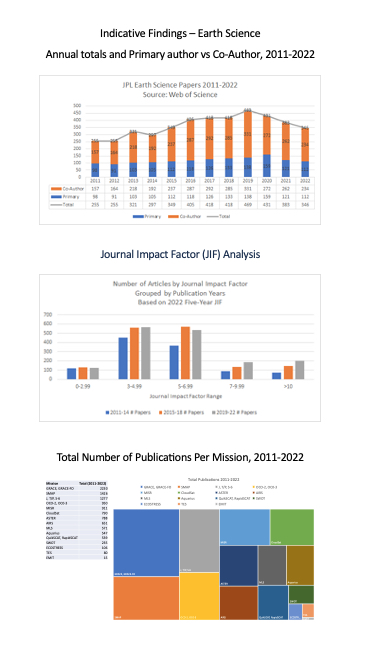Meeting Documents
Analyzing Trends in Science Publications to Determine Impact – Earth Science, Planetary Science, and Astrophysics
Presented at: AGU Annual Meeting 2024
Abstract

Historical and recent trends in the publication of research results can be informative for the assessment of a science organization’s workforce, its funding and programmatic support, and its overall accomplishments, and be helpful for strategic planning for the coming decades. A partnership between the Earth Science directorate and the Library at Jet Propulsion Laboratory is undertaking an analysis of the number, quality, and areas of concentration of JPL's peer-reviewed science publications. The project is co-developed and supervised by the Directorate Scientist for Earth Sciences and Library and Information Science (LIS) specialists at JPL, along with input from the Directorate Scientists from JPL's Astrophysics and Planetary Programs, JPL data science subject matter experts, the Laboratory Chief Scientist, and the Office of Research and Development.
Initially conceived to examine Earth Science publications, the project supervisors developed a prototype approach that included initial examinations of the trends in Earth Science publications in association with:
- JPL's Earth Science missions (e.g. AIRS, MLS, TES, GRACE, OCO-2)
- Our Earth system science areas of concentration (e.g. carbon, energy and water cycles)
- Our Earth system model activities (e.g. ISSM - ice sheet model, CMS-Flux - carbon and greenhouse gas models, ECCO - global ocean model)
- Through a lens of societal benefit (e.g. air quality, water availability, greenhouse gas mitigation, sea level measurement, biodiversity, and others).
Analysis factors include the number of publications that cite data from JPL missions, the number of publications authored by JPL as either first or contributing author, changes in publication data over time, and other developments to add more fidelity to these questions to reveal and analyze trends. The charts included here represent indicative findings from the initial Earth Science publication analysis.
Based on the success of the initial phase and having broadened the project scope to include planetary science and astrophysics, JPL brought in a LIS graduate intern to expand this initial curation and assessment and address some of the challenges we've encountered in producing a robust report that can be actionable relative to our strategic planning.

Historical and recent trends in the publication of research results can be informative for the assessment of a science organization’s workforce, its funding and programmatic support, and its overall accomplishments, and be helpful for strategic planning for the coming decades. A partnership between the Earth Science directorate and the Library at Jet Propulsion Laboratory is undertaking an analysis of the number, quality, and areas of concentration of JPL's peer-reviewed science publications. The project is co-developed and supervised by the Directorate Scientist for Earth Sciences and Library and Information Science (LIS) specialists at JPL, along with input from the Directorate Scientists from JPL's Astrophysics and Planetary Programs, JPL data science subject matter experts, the Laboratory Chief Scientist, and the Office of Research and Development.
Initially conceived to examine Earth Science publications, the project supervisors developed a prototype approach that included initial examinations of the trends in Earth Science publications in association with:
- JPL's Earth Science missions (e.g. AIRS, MLS, TES, GRACE, OCO-2)
- Our Earth system science areas of concentration (e.g. carbon, energy and water cycles)
- Our Earth system model activities (e.g. ISSM - ice sheet model, CMS-Flux - carbon and greenhouse gas models, ECCO - global ocean model)
- Through a lens of societal benefit (e.g. air quality, water availability, greenhouse gas mitigation, sea level measurement, biodiversity, and others).
Analysis factors include the number of publications that cite data from JPL missions, the number of publications authored by JPL as either first or contributing author, changes in publication data over time, and other developments to add more fidelity to these questions to reveal and analyze trends. The charts included here represent indicative findings from the initial Earth Science publication analysis.
Based on the success of the initial phase and having broadened the project scope to include planetary science and astrophysics, JPL brought in a LIS graduate intern to expand this initial curation and assessment and address some of the challenges we've encountered in producing a robust report that can be actionable relative to our strategic planning.

